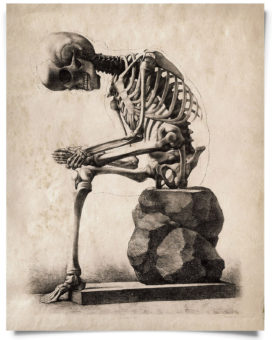“Old People from Texas eat spiders” (head bones).
“Virgil Can Not Make My Pet Zebra Laugh” (facial bones).
In high school biology I tried to memorize all the bones in the human body. If the teacher called on you and you could recite some bone systems (cranium, wrist, shoulder, etc.), you’d get extra credit. I could remember some because of their catchy mnemonics, but too often I was thoroughly distracted by the lovely Suzette L _____, who sat in front of me, whose entire body, from head to toe, I will never forget. Who frequently turned back to whisper to the girl sitting next to me, revealing her enchanting profile. Ah, those lovely bones: zygomatic (cheek); mandible (jaw); and inferior nasal concha, palatine, and vomeronasal cartilage (nose). And more: the bright blue eyes (framed by the nasal, lacrimal, and zygomatic bones), the blond curls (undergirded by six or seven of the cranial bones), the captivating smile (mandible, maxilla, plus a bunch of muscles). And when at the end of the class she stood and gathered her books in the basket of her arms, forcing a sumptuous amplitude forward…all bones were forgotten in that splendid moment.
“The anus is nothing, it’s just a hole!” Thus, several years later in the large lecture classroom, my Biology 101 prof as he concludes a didactic journey through the human alimentary canal.
And a querulous student voice: “Do we have to poke holes in those poor frogs? I don’t have the heart for it.” And the prof: “Three things: Number 1: It’s called pithing. You pith frogs.” Scattered titters through the lecture hall.
I hear a whisper from several rows behind me: “Did you know that they piss when they’re pithed?”
Another whispers: “I guess it really piths them off.” Localized suppressed laughter.
Disgusted look on the prof’s face. “You have something to share back there? No? All right. Number 2: Yes, you do have to pith frogs. Or would you rather work with cadavers?” Silence except for a few groans. “Number 3: The heart is not the seat of emotions. It’s here in the brain”—tapping his head — where all thoughts and feelings originate. Get this! The Mesopotamians thought it was the liver!” Here he slaps the right side of his besuited belly, distaste on his face, as if he would spit were he not in the lecture hall. “Heart, liver, whatever. That’s not science! That’s nonsense! That’s just poetry!” He pauses, clears his throat. Smiles condescendingly. “And speaking of brains and hearts: The octopus has nine of one and three of the other. (I’ll leave it to you to find out which is which.) We humans somehow get by with only one of each. Furthermore, the octopus, like the banana, has no bones.” Puzzled looks throughout the lecture hall. “The octopus makes do with just cartilage. This allows it to squeeze through the tiniest spaces, unlike the great escape artist Houdini, whose many bones severely limited his abilities.” Pauses. Continues to smile condescendingly. “My next lecture is on the human skeleton. Who can tell me how many bones are in the body of a fully grown human? (Which you may assume yourselves to be.)”

